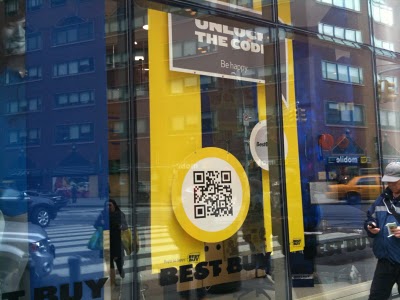I was at Best Buy the other night helping a friend buy a new notebook computer, and she saw one of those QR codes I’ve been blogging about. First of all, I’m excited that those who know me, and those who follow me on my blog and on my QR code facebook page can identify these 2D barcodes out in the wild! They know what they’re for, even if they haven’t tried snapping a QR code before from their own device.
So, of course I had to whip my iPhone out and snap that QR code with one of the many free reader apps available (search for iCandyMobile in the AppStore, that’s currently the one I use most). Snapping the code took me to the Best Buy website and immediately pulled up the model information page for the Toshiba computer we wanted to know more about. We were able to see all of the information that was on the info card next to the computer, plus all the detailed specs that were not on the card and unknown to the teenager wanting to help me. Cool 🙂
The concept behind scanning a QR code and viewing more information on my mobile is pretty great, but Best Buy has one of the best implementations I’ve seen. They followed an important “best practice” of ensuring the URL for each QR code took me to a mobile-friendly page which was optimized for my iPhone. The webpage was attractive and informative, and I could use the nicer features of my smartphone’s browser to be able to zoom into larger images and toggle animated panels of exactly the features and specifications I wanted to see.
Best Buy also took the opportunity to create a long-term relationship with me based on my short-term action of snapping that QR code, which is important in supporting brand loyalty and therefore revenue. This was accomplished by allowing me to sign into my current Best Buy account, or to create a new one from the product page I had visited. The page auto-filled my zip code in after I allowed their website to use my GPS location, and I could find other stores with that computer in stock. From the same page, I had the option to read reviews on the product from other customers, and even add the notebook to my shopping cart with a single click! Ok, at that point if the product was in stock, I could simply pick it up off the shelf and put it in my real shopping cart parked in front of me, but it’s a great feature when a store has run out of something still available from their website.
Overall, I was very happy with the experience – save one thing. There were only 2 products out of the tens or more we looked at that had QR codes! I couldn’t find out more about all of the other products sitting next to the Toshiba notebook, nor could I read the reviews posted by other consumers. Taking a list of the products I was interested in would have required me to resort to typing out long and funky model numbers on my phone and taking some rough photos of the product myself.
How does one encourage a huge company like Best Buy to spend time and effort on affixing QR codes to all of their retail product displays, their marketing and promotional materials, and maybe even their price tags? I’m already looking into it, and will publish my findings soon 🙂
Remember, today Sunday Aug 29th is the last day of voting for my panel topic at next year’s SXSW Interactive Festival! So please take the time to vote for my panel entitled QR Who QR: Exploring QR Codes, it only takes a few mins to sign up for an account, and they won’t spam the heck outta ya. Leave me a comment or question on the page after you’ve voted, I’d love to hear what people think and it happens to help me in the selection process!
